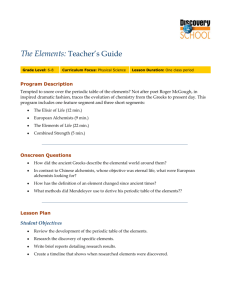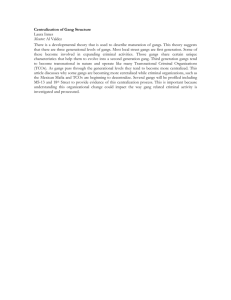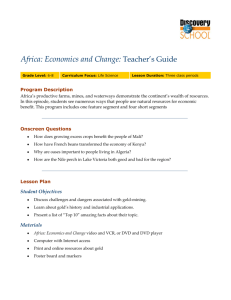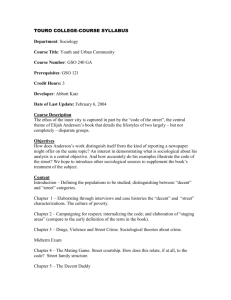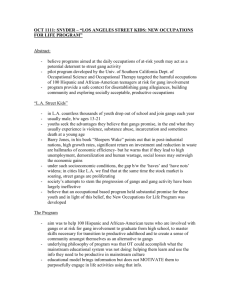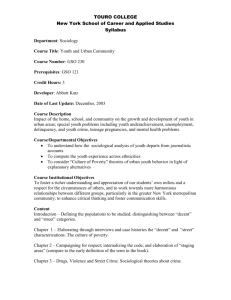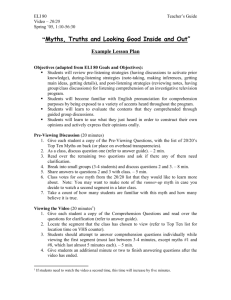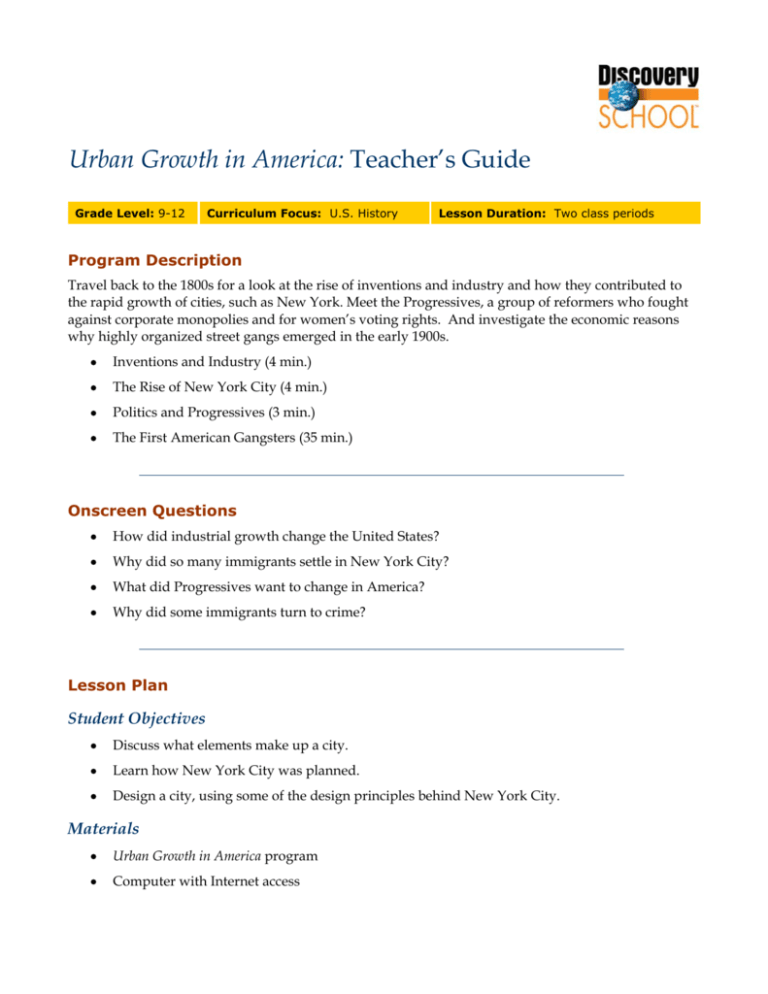
Urban Growth in America: Teacher’s Guide
Grade Level: 9-12
Curriculum Focus: U.S. History
Lesson Duration: Two class periods
Program Description
Travel back to the 1800s for a look at the rise of inventions and industry and how they contributed to
the rapid growth of cities, such as New York. Meet the Progressives, a group of reformers who fought
against corporate monopolies and for women’s voting rights. And investigate the economic reasons
why highly organized street gangs emerged in the early 1900s.
•
Inventions and Industry (4 min.)
•
The Rise of New York City (4 min.)
•
Politics and Progressives (3 min.)
•
The First American Gangsters (35 min.)
Onscreen Questions
•
How did industrial growth change the United States?
•
Why did so many immigrants settle in New York City?
•
What did Progressives want to change in America?
•
Why did some immigrants turn to crime?
Lesson Plan
Student Objectives
•
Discuss what elements make up a city.
•
Learn how New York City was planned.
•
Design a city, using some of the design principles behind New York City.
Materials
•
Urban Growth in America program
•
Computer with Internet access
Urban Growth in America: Teacher’s Guide
•
Newsprint and markers
•
Poster board or large sheets of newsprint
•
Markers or colored pencils
2
Procedures
1. Ask students what they know about cities and list their answers on a sheet of newsprint.
Possible answers include the following:
•
In cities, many people live together in a small space.
•
Skyscrapers are one kind of building found in cities.
•
Many people go to cities in search of jobs.
•
Buses and trains travel in and out of cities.
2. Show students the “Inventions and Industry“ and “The Rise of New York City” segments in the
Urban Growth in America program.
3. Divide students into groups of three or four and explain that they will design their own cities.
Along with what they’ve just learned about urban growth, they should also use their own
knowledge of cities to guide their designs. Remind them that their cities should include all of
the necessary elements and should be planned in a logical fashion.
4. After giving the groups time to develop an initial list of necessary elements, tell students that
they must include these items it their city design:
•
A street design, such as the grid system used in New York City
•
A plan for infrastructure—electricity, plumbing, garbage disposal, etc.
•
Places for people to live
•
Places for people to work
•
Restaurants, movie theatres, sports and concert arenas, and other places for
entertainment
•
Parks and other recreational areas
5. Provide each group with poster board or large pieces of newsprint and colored pencils or
markers. Give the groups class time to draw a blueprint for their cities. If needed, have students
finish the assignment as homework.
6. During the next class, have the groups share their city designs and discuss the students’ ideas.
Ask: How did each group fit in all the necessary elements? Do people have enough room to live
and work comfortably?
7. Ask students to name some of the problems associated with cities, such as crime. Looking at
their designs, can they see any contributing factors for these problems? (For example,
overcrowding or competition for goods and services.) Show students “The First American
Gangsters” segment in the Urban Growth in America program.
Published by Discovery Education. © 2005. All rights reserved.
Urban Growth in America: Teacher’s Guide
3
Assessment
Use the following three-point rubric to evaluate students' work during this lesson.
•
3 points: Students were highly engaged in class and small-group discussions; produced an
attractive, logical design for a city that had all the requested components; presented their
ideas to the class in a clear, thoughtful way.
•
2 points: Students participated in class and small-group discussions; produced an adequate
design for a city that had most of the requested components; presented their ideas to the
class satisfactorily.
•
1 point: Students participated minimally in class and small-group discussions; did not
complete a design for a city or completed one that had little or none of the requested
components; did not present their ideas clearly to the class.
Vocabulary
city
Definition: A large area where people live and work that also has importance as a commercial
and cultural center
Context: The city is a center of activity, with many opportunities for recreation, including
shopping and attending cultural events.
design
Definition: A plan for something that lays out where things should go and how the different
elements work together
Context: The design for New York City was based on the grid system, where the roads were laid
out in an orderly way.
Thomas Edison
Definition: Inventor of the electric light bulb and of a large-scale electrical system
Context: On December 31, 1879, Thomas Edison displayed his electrical light system by lighting
up the streets of Menlo Park, New Jersey, where his laboratory was located.
infrastructure
Definition: The underlying foundation of a system, such as a city
Context: The infrastructure of a city includes the power grid, the sewage system, and the way
water is supplied.
skyscraper
Definition: A tall building that is an efficient use of space in a city
Context: Not only could many people fit into a skyscraper, this building was once a status
symbol for a city.
Published by Discovery Education. © 2005. All rights reserved.
Urban Growth in America: Teacher’s Guide
4
Academic Standards
Mid-continent Research for Education and Learning (McREL)
McREL's Content Knowledge: A Compendium of Standards and Benchmarks for K-12 Education
addresses 14 content areas. To view the standards and benchmarks, visit http://www.mcrel.org/.
This lesson plan addresses the following national standards:
•
U.S. History: Era 6—Understands massive immigration after 1870 and how new social
patterns, conflicts, and ideas of national unity developed amid growing cultural diversity
•
Language Arts: Viewing—Uses a range of strategies to interpret visual media
The National Council for the Social Studies (NCSS)
NCSS has developed national guidelines for teaching social studies. To become a member of NCSS,
or to view the standards online, go to http://www.socialstudies.org
This lesson plan addresses the following thematic standards:
•
Culture
•
Time, Continuity, and Change
Support Materials
Develop custom worksheets, educational puzzles, online quizzes, and more with the free teaching tools
offered on the Discoveryschool.com Web site. Create and print support materials, or save them to a
Custom Classroom account for future use. To learn more, visit
•
http://school.discovery.com/teachingtools/teachingtools.html
DVD Content
This program is available in an interactive DVD format. The following information and activities are
specific to the DVD version.
How to Use the DVD
The DVD starting screen has the following options:
Play Video—This plays the video from start to finish. There are no programmed stops, except by
using a remote control. With a computer, depending on the particular software player, a pause
button is included with the other video controls.
Published by Discovery Education. © 2005. All rights reserved.
Urban Growth in America: Teacher’s Guide
5
Video Index—Here the video is divided into four segments (see below), indicated by video
thumbnail icons. Watching all parts in sequence is similar to watching the video from start to finish.
Brief descriptions and total running times are noted for each part. To play a particular segment,
press Enter on the remote for TV playback; on a computer, click once to highlight a thumbnail and
read the accompanying text description and click again to start the video.
Curriculum Units—These are specially edited video segments pulled from different sections of the
video (see below). These nonlinear segments align with key ideas in the unit of instruction. They
include onscreen pre- and post-viewing questions, reproduced below in this Teacher’s Guide. Total
running times for these segments are noted. To play a particular segment, press Enter on the TV
remote or click once on the Curriculum Unit title on a computer.
Standards Link—Selecting this option displays a single screen that lists the national academic
standards the video addresses.
Teacher Resources—This screen gives the technical support number and Web site address.
Video Index
I. Inventions and Industry (4 min.)
The Industrial Revolution brought major changes to the United States. Explore how industrial
growth changed America and examine life in 19th-century cities.
II. The Rise of New York City (4 min.)
New York City was a major hub of U.S. industrial growth in the 19th century. Tour the engineering
history of “the city that never sleeps.”
III. Politics and Progressives (3 min.)
The Progressives worked to address and correct the urban problems of corruption and dangerous
workplace conditions. Learn about Progressivism and see how Teddy Roosevelt and other leaders
reformed society.
IV. The First American Gangsters (35 min.)
America has long been fascinated with urban gangsters. Travel back in time to discover the roots of
organized crime and learn about Al Capone and other such infamous gangsters.
Curriculum Units
1. Industrialization in America
Pre-viewing question
Q: What appliances, tools, and gadgets do you use daily?
A: Answers will vary.
Published by Discovery Education. © 2005. All rights reserved.
Urban Growth in America: Teacher’s Guide
6
Post-viewing question
Q: What was life like for most 19th-century immigrant workers?
A: Most immigrant workers lived in big city slums, commonly working 60 hours a week. They
received no pensions or payments if they were injured or lost their jobs. Their living conditions
were crowded and unsanitary, which lead to outbreaks of disease that spread quickly.
2. History of the Big Apple
Pre-viewing question
Q: What do you like about New York City?
A: Answers will vary.
Post-viewing question
Q: What would be the reaction of 19th-century city planners in New York City today?
A: Answers will vary.
3. Progressive Solutions to Urban Problems
Pre-viewing question
Q: What would you like to change about the United States?
A: Answers will vary.
Post-viewing question
Q: How did Teddy Roosevelt uphold the ideals of the Progressives?
A: Teddy Roosevelt was the first Progressive president. He used his office to break up many
business trusts, or huge combinations of companies that used their economic power to take
advantage of their competitors and workers. Roosevelt enacted the Square Deal, which was
designed to give all Americans an equal chance to succeed. He created the Pure Food and Drug Act
to protect American consumers, and he established the National Park system to conserve the
environment.
4. New York’s Early Street Gangs
Pre-viewing question
Q: Describe what you consider a typical gangster.
A: Answers will vary.
Post-viewing question
Q: What similarities exist between modern gangs and 19th-century street gangs?
A: Street gangs in the 19th century wore specific colors, called their headquarters “cribs,” spoke of
ruling their turf, and they used gang signs, similar to those of gangs today.
5. Getting Out of the Slums
Pre-viewing question
Q: Why do people join gangs?
A: Answers will vary.
Published by Discovery Education. © 2005. All rights reserved.
Urban Growth in America: Teacher’s Guide
7
Post-viewing question
Q: What advantages did gangs offer immigrants in the 19th century?
A: Answers will vary.
6. The Black Hand
Pre-viewing question
Q: Why do you think gangsters receive attention in the media?
A: Answers will vary.
Post-viewing question
Q: Describe the Black Hand.
A: Established by a group of Italians, this street gang rapidly provoked a reign of terror with
vicious extortion. Its members sent extortion letters signed with a black handprint; if victims
refused to comply with the gang, they would pay heavy consequences. Black Hand gang members
wore hats and mustaches, which earned them the name “Mustache Petes.”
7. Gang Business
Pre-viewing question
Q: What tactics do people use to manipulate others?
A: Answers will vary.
Post-viewing question
Q: What activities did New York’s 19th-century gangs take part in?
A: New York City gangs defended their territories and fought turf wars over areas where the
winning gang would have the exclusive right to commit crimes. By the early 1900s, gangs were also
acting as contract assassins, taking cash to kill people.
8. An Era of Gangster Films
Pre-viewing question
Q: Why might gangster movies be popular with the public?
A: Answers will vary.
Post-viewing question
Q: How did Musketeers of Pig Alley differ from other movies of the time?
A: It was the first true gangster movie. The director filmed on location rather than in a studio,
having paid local gang bosses to protect his equipment. The extras used in the filmmaking were
real gangsters. The use of authentic gangsters onscreen caused a sensation and gave the movie a
feeling of reality that was missing from other pictures.
9. Movie Gangsters Influence American Culture
Pre-viewing question
Q: In what ways does Hollywood set American style trends?
A: Answers will vary.
Published by Discovery Education. © 2005. All rights reserved.
Urban Growth in America: Teacher’s Guide
Post-viewing question
Q: In what ways has the look of “gangster style” changed over the years?
A: Answers will vary.
10. Well-Organized Crime
Pre-viewing question
Q: What do you know about the Mafia?
A: Answers will vary.
Post-viewing question
Q: Who do you think was the cause of the Mafia’s rise to power?
A: Answers will vary.
11. White-Collar Crime
Pre-viewing question
Q: What do consider white-collar crimes?
A: Answers will vary.
Post-viewing question
Q: What were the effects of street gangs on the community?
A: Answers will vary.
12. Al Capone and Prohibition
Pre-viewing question
Q: What do you know about Al Capone?
A: Answers will vary.
Post-viewing question
Q: Do you think Al Capone could have been successful if he hadn’t been a gangster?
A: Answers will vary, but students may cite the following as evidence that he could have been
successful in another field: Unlike other gangsters, Capone’s instinct for public relations was his
key to success. He understood that speaking well and acting polite were often as effective as
violence. He employed anyone with talent and could sway people to his causes through the use of
charm instead of threats.
Published by Discovery Education. © 2005. All rights reserved.
8

